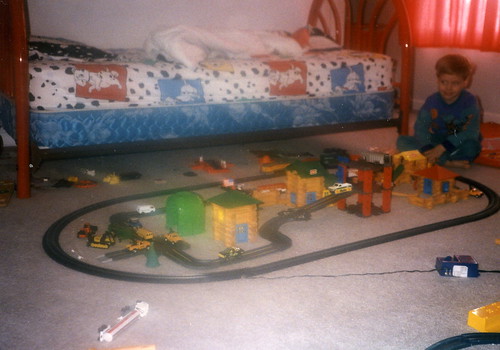This post ended up getting really, really long, so I broke it up into various elements that I will share over the next few days . . .
JoVe from Tricotomania wrote a post called “Contemplations on the School Year.” I would like to share some experiences our family has chosen as well as my own thoughts on some issues she brings up. To begin, JoVe said:
I have been struck recently by how much homeschoolers seem to be tied to the school year. Many of the blogs I read commented on stopping for the summer, or starting up again recently.
Later, she adds:
I suspect that those with more onerous reporting requirements find that the reporting timetable has some influence on the timetable of their activities. That said, I’ve noticed at least a couple of mentions of ‘logging’ activities during the summer that will count towards compulsory hours spent or whatever.
For the first about thirteen years of having children, my older children didn’t understand the impact of “summer vacation”. Oh, they had heard it, because most of their friends have been public or private schooled, but it didn’t impact them in a way that made them take a close look at it. We were strong unschoolers in the early developmental learning stages of my children’s lives, so learning happened all day and all year long without any significant formal learning activities.
During that time for our family, there were natural shifts that occurred when school started for their friends. Instead of playing almost all day long with them, all of a sudden, their friends attended school for much of the day and then homework loomed before play could begin. Instead of seeing this as a problem, my children seemed to take the beginning of school for their friends as a natural time to use for their own creative outlets and alone time (being so many of mine are introverts) instead of having to reject a friend’s invitation to play when my child was interested in refueling alone. I believe “homework” had a negative connotation to my children, because once the school bus dropped off their friends in the neighborhood, my children expected free access to them, but “doing their homework first” was the gulf between them.
As I reflect on our family’s rhythms and activity choices, I feel weather impacts our schedules more than school. For our family, late spring through summer and into early fall provides more opportunities for diverse learning outdoors. The natural science world is alive and fully operating in its glory. It has more pleasant weather opportunities, where we have lived, for active outdoor play whether at playgrounds, street play (since we have usually lived on cul-de-sacs), forest explorations, sporting activities, and zoo visits. Long-distance traveling also is more appealing for the predictable driving conditions, particularly toward those water destinations and camping endeavors. Overall, summer is higher on the list for outdoor learning activities!
On the other hand, winter time is when we all like to do another type of learning that brings us inward . . . physically and mentally. This is the time I found our family doing the family read alouds, personal reading, drawing, building Legos, and generally more focused learning. Simply in regard to the weather, there was less friend interaction, and more alone time. For trips, winter time seems to encourage visits to the museums, libraries, and other indoor facilities. This was also the time to plan the “out-of-season” special excursions.
Our family capitalizes on what each season offers as it pertains to learning. For example, my hubby enjoys science so he gathered the children together for “nature time with dad” in the early fall that was nature walk driven. He created “Science with Mad Dad” in the winter that was experiment driven. Further, sometime between 11-13 years of age, each child and I would collaborate together in creating a more formal, goal-oriented rhythm to their learning. By the time they were 13, each would usually be working on their own from a schedule we created together that would entail a “full workload” of about 3-4 hours of formal goal-based learning. This internal mind work was geared toward winter, so we often start up on these goals in October and end in March. It was at this time that Abbey proclaimed, “Oh, now I know why summer vacation is something my friends looked forward to!” as she anticipated “taking a break” from her full schedule down to a self-determined pared-down version for the summer. Of course, she realized that she was choosing when she was finished with this type of learning based on the “call of the outdoors” beckoning.
That said, I absolutely recorded all of these activities, good weather activities as much or more than the winter activities, on any formal reporting needs we had to accomplish for our state’s homeschooling requirements. I made specific note to myself that most states end the “school year” one day, and the next day is considered the beginning of the next “school year”, and so it could be reflected in our reporting requirements!
Eric and Abbey playing in a creek in the summer:
The mean http://respitecaresa.org/fiesta-noche-del-rio-will-support-the-kids-of-respite-care/ cheapest viagra age of the men was 59.2 years.

Eric and Abbey playing at the museum in the winter:
Eli creating his “worlds” in the winter:
Eli playing a water game with siblings and friends in the summer:




Pingback: Apple Stars » Blog Archive » Family Rhythms vs. School Rhythms: Travel and Community Activities